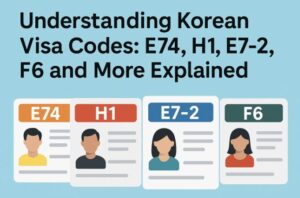If you’ve searched for things like “What is the E74 visa in Korea?” or “What does the F6 visa mean?”, you’re not the only one. Korea uses alphanumeric codes to identify different types of visas, each tied to specific purposes—like employment, family, or working holiday.
In this guide, we’ll break down 5 commonly asked Korean visa codes: E74, H1, E7-2, F6, and 182. This will help you understand your visa type or choose the right one for your situation.

What is the E74 Visa in Korea?
The **E-7-4 visa** (commonly shortened as E74) is part of Korea’s “Employment Visa” category. This visa is issued under a special **points-based system**, designed to allow long-term foreign workers—especially those in essential skilled labor positions—to stay in Korea with more stability.
✅ Key points:
– Requires you to accumulate enough points based on work experience, Korean language ability, income, and time spent in Korea
– Often used by manufacturing, service, and IT workers who were previously on E-9 or D-10
– Can be a step toward permanent residency (F-2 or F-5)
👉 Learn more at the official guide:
Korea Visa Portal – E7-4 Program Details
What is an H1 Visa in Korea?
The **H-1 Working Holiday visa** allows young adults from specific countries to stay in Korea for up to 1 year, combining travel with part-time work.
✅ Who can apply:
– Ages 18–30 (up to 35 for some countries)
– Must be from one of the countries that has a working holiday agreement with Korea (e.g., Australia, Canada, New Zealand, UK, France, etc.)
✅ What you can do:
– Work in non-professional jobs (like cafes, guesthouses, English camps)
– Enroll in Korean language or cultural programs
– Travel freely within Korea
👉 Full list of eligible countries and requirements:
Korea Visa Portal – H1 Working Holiday Info
What is an E7-2 Visa in Korea?
The **E-7-2 visa** is a subset of the E-7 category, specifically targeting foreign skilled workers in designated professions.
✅ Common jobs for E7-2 visa holders:
– Engineers
– Programmers
– Culinary professionals
– Designers
– Foreign language instructors (outside the E2 scope)
✅ Requirements:
– Employment contract with a Korean company
– Relevant academic degree or career experience in the field
– Clear job classification that aligns with Korean labor needs
👉 Check eligibility and job categories here:
HiKorea – E-7 Visa Guidelines
What is the F6 Visa in Korea?
The **F-6 visa** is a **spouse visa** issued to foreign nationals who are legally married to Korean citizens. This visa allows for long-term stay and is often a pathway to permanent residency (F-5).
✅ Types of F-6:
– F-6-1: Marriage to Korean citizen
– F-6-2: For children born in Korea
– F-6-3: Spouses undergoing divorce or whose Korean spouse has passed away
✅ Benefits:
– You can work freely in Korea without employer sponsorship
– You can access public health insurance and national pension
– Eligible to apply for F-5 permanent residency after meeting residency conditions
👉 Read official F6 visa rules:
HiKorea – F6 Marriage Visa Info
What is ‘182’ in Korea?
You might see “182” appear in search results or forms, and wonder: what does it mean?
🔎 **Answer:**
“182” is not a visa type. It refers to the **immigration hotline number** in Korea. This number connects you to the Korea Immigration Contact Center (KICC), where you can get help in English, Chinese, Vietnamese, Tagalog, and more.
📞 Dial **1345** (from inside Korea)
– Press 1 for Korean
– Press 2 for English
– Open Monday to Friday, 09:00 to 18:00
👉 More about the center:
Korea Immigration Contact Center (KICC)
In Summary: Korean Visa Codes Made Simple
| Visa Code | Purpose | Who It’s For |
|———–|———|————–|
| E-7-4 | Points-based Employment | Skilled workers aiming for stability |
| H-1 | Working Holiday | Young adults from eligible countries |
| E-7-2 | Specialized Work | Engineers, chefs, IT, etc. |
| F-6 | Marriage Visa | Spouses of Korean nationals |
| 182 | Immigration Hotline | Not a visa, it’s a contact number |
Want to Learn More?
We’re preparing additional guides on:
– How to change from D-10 to E-7
– How to convert F-6 to F-5 (permanent resident)
– How to apply for the points-based F-2-7 visa
Stay tuned for our next visa article.
💬 Need Help While Traveling in Korea?
Are you currently in Korea and facing any difficulties with transportation, booking, communication, or anything else?
We’re building a support service just for travelers like you. Tell us what kind of help you need — we’re here to listen and assist!
Your answers will help us create better services for travelers in Korea. Thank you!